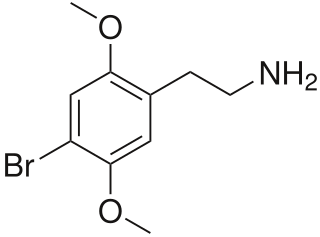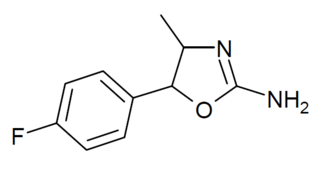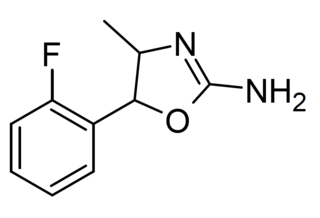
2C-B (4-bromo-2,5-dimethoxyphenethylamine) is a synthetic psychedelic drug of the 2C family, initially synthesized by Alexander Shulgin in 1974 and commonly used as a recreational drug. There is limited scientific information regarding the drug's pharmacokinetics and pharmacological effects in humans. The existing studies primarily classify 2C-B as a stimulant, and hallucinogen, and less commonly as an entactogen, and empathogen.

2C-T-7 is a psychedelic phenethylamine of the 2C family. In his book PiHKAL: A Chemical Love Story, Alexander Shulgin lists the dosage range as 10–30 mg. 2C-T-7 is generally taken orally, and produces psychedelic and entactogenic effects that last 8 to 15 hours. Up until Operation Web Tryp and three deaths, two of which involved the use of other drugs in addition to 2C-T-7, and one which involved an excessive insufflated dose, 2C-T-7 was sold commercially in Dutch and Japanese smartshops and online. It is known on the streets as Blue Mystic or 7th Heaven. There has been little real research done on this chemical other than Shulgin's comments in PiHKAL and a few small animal studies mostly aimed at detecting metabolites.

2C-D is a psychedelic drug of the 2C family that is sometimes used as an entheogen. It was first synthesized in 1970 by a team from the Texas Research Institute of Mental Sciences, and its activity was subsequently investigated in humans by Alexander Shulgin. In his book PiHKAL, Shulgin lists the dosage range as being from 20 to 60 mg. Lower doses of 10 mg or less have been explored for microdosing.

2C-B-FLY is a psychedelic phenethylamine and designer drug of the 2C family. It was first synthesized in 1996 by Aaron Monte, Professor of Chemistry at UW-La Crosse.

BOB (4-bromo-2,5,beta-trimethoxyphenethylamine) is a lesser-known psychedelic drug. It is the beta-methoxy analog of 2C-B. BOB was first synthesized by Alexander Shulgin. In his book PiHKAL, the dosage range is listed as 10–20 mg, and the duration listed as 10–20 hours. BOB produces an altered state of consciousness, tinnitus, a pleasant tingling throughout the body, and a sense of awareness. Very little data exists about the pharmacological properties, metabolism, and toxicity of BOB.

2CBCB-NBOMe (NBOMe-TCB-2) is a compound indirectly derived from the phenethylamine series of hallucinogens, which was discovered in 2007 at Purdue University as part of the ongoing research program of the team led by David Nichols focusing on the mapping of the specific amino acid residues responsible for ligand binding to the 5HT2A receptor. 2CBCB-NBOMe acts as a potent and selective agonist for the 5-HT2A and 5-HT2C receptors, with a Ki of 0.27 nM at the human 5-HT2A receptor, a similar potency to other agonists such as TCB-2, NBOMe-2C-I and Bromo-DragonFLY.

2CBFly-NBOMe is a compound indirectly derived from the phenethylamine hallucinogen 2C-B, and related to benzodifurans like 2C-B-FLY and N-benzylphenethylamines like 25I-NBOMe. It was discovered in 2002, and further researched by Ralf Heim at the Free University of Berlin, and subsequently investigated in more detail by a team at Purdue University led by David E. Nichols. It acts as a potent partial agonist for the 5-HT2A serotonin receptor subtype.

25B-NBOMe is a derivative of the phenethylamine psychedelic 2C-B, discovered in 2004 by Ralf Heim at the Free University of Berlin. It acts as a potent full agonist for the 5HT2A receptor. Anecdotal reports from users suggest 25B-NBOMe to be an active hallucinogen at a dose of as little as 250–500 µg, making it a similar potency to other phenethylamine derived hallucinogens such as Bromo-DragonFLY. Duration of effects lasts about 12–16 hours, although the parent compound is rapidly cleared from the blood when used in the radiolabeled form in tracer doses. Recently, Custodio et al (2019) evaluated the potential involvement of dysregulated dopaminergic system, neuroadaptation, and brain wave changes which may contribute to the rewarding and reinforcing properties of 25B-NBOMe in rodents.

βk-2C-B is a novel psychedelic substance. It is the beta (β) ketone structural analogue of 2C-B, a psychedelic drug of the 2C family. It is used as a recreational drug, usually taken orally. βk-2C-B is a controlled substance in Canada, Germany, Switzerland, and the United Kingdom.

4,4'-Dimethylaminorex, sometimes referred to by the street name "Serotoni", is a psychostimulant and entactogen designer drug related to aminorex, 4-methylaminorex, and pemoline. It was first detected in the Netherlands in December 2012, and has been sold as a designer drug around Europe since mid-2013.

25B-NBOH is a derivative of the phenethylamine derived hallucinogen 2C-B which has been sold as a designer drug. It acts as a potent serotonin receptor agonist with similar affinity to the better-known compound 25B-NBOMe at 5-HT2A and 5-HT2C receptors with pKis values of 8.3 and 9.4, respectively.

2C-B-BUTTERFLY is a conformationally-restricted derivative of the phenethylamine hallucinogen 2C-B, which was discovered in 1999 by Michael S. Whiteside and Aaron Monte. It is a ring-expanded homologue of the better known compound 2C-B-FLY, and has similar properties as an agonist for serotonin receptors, but with more selectivity for 5-HT2C over 5-HT2A.

25B-NBF is a derivative of the phenethylamine hallucinogen 2C-B, which acts as a highly potent partial agonist for the human 5-HT2A receptor.

2,5-dimethoxy-4-bromophenylpiperazine (2C-B-PP) is a drug of the phenylpiperazine class. It acts as an agonist at serotonin receptors, and in studies on rats substituted for the psychedelic amphetamine derivative DOM with around 1/10 the potency but similar rates of stimulus-appropriate responding at the highest dose.

4'-Fluoro-4-methylaminorex is a recreational designer drug from the substituted aminorex family, with stimulant effects. It was first detected in Slovenia in 2018. It was made illegal in Italy in March 2020.

3',4'-Methylenedioxy-4-methylaminorex (MDMAR) is a recreational designer drug from the substituted aminorex family, with monoamine releasing effects.

2C-B-DRAGONFLY (2C-B-DFLY) is a recreational designer drug with psychedelic effects. It can be regarded as the fully aromatic derivative of 2C-B-FLY. 2C-B-DRAGONFLY is stronger than 2C-B or 2C-B-FLY with around 2-3x the potency of 2C-B in animal studies, demonstrating the importance of the fully aromatic benzodifuran ring system for optimum receptor binding at 5-HT2A, but it is still considerably less potent than its alpha-methyl derivative Bromo-DragonFLY.

4'-Chloro-4-methylaminorex is a recreational designer drug from the substituted aminorex family, with stimulant effects. It has reportedly been sold since around 2021 and was first definitively identified in Austria in January 2022.

2'-Fluoro-4-methylaminorex is a recreational designer drug from the substituted aminorex family, with stimulant effects, first reported in 2018.

4'-Bromo-4-methylaminorex is a designer drug from the substituted aminorex family, first definitively identified in Austria in January 2022. Its pharmacological activity has not been reported, but it is believed to have stimulant effects.




















